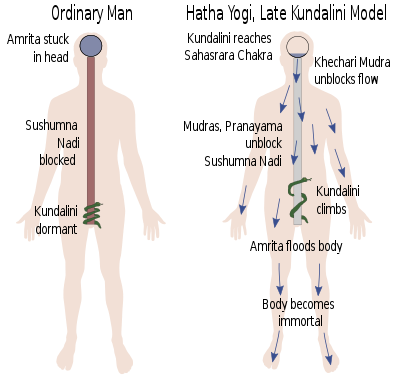Hatha Yoga Pradipika

The Haṭha Yoga Pradīpikā (
More recently, eight works of early hatha yoga that may have contributed to the Hatha Yoga Pradipika have been identified.
Title and composition
| Hatha Yoga Pradipika 2.40–41, 2.77, translated by Mallinson & Singleton |
|---|
| As long as the rajayoga state.[2]
|
Different manuscripts offer different titles for the text, including Haṭhayogapradīpikā, Haṭhapradīpikā, Haṭhapradī, and Hath-Pradipika.
Summary
The Hatha Yoga Pradīpikā lists thirty-five earlier Haṭha Yoga masters (
- Chapter 1 deals with setting the proper environment for yoga, the ethical duties of a yogi, and the asanas.
- Chapter 2 deals with pranayama and the satkarmas.
- Chapter 3 discusses the mudras and their benefits.
- Chapter 4 deals with meditation and samadhi as a journey of personal spiritual growth.
It runs in the line of
Mechanisms
The Hatha Yoga Pradipika presents two contradictory models of how Hatha Yoga may lead to immortality (moksha), both culled from other texts, without attempting to harmonise them.[6]
The earlier model involves the manipulation of
The later model involves the stimulation of Kundalini, visualised as a small serpent coiled around the base of the Sushumna nadi. In this model, the mudras serve to unblock the channel, allowing Kundalini to rise. When Kundalini finally reaches the top at the Sahasrara chakra, the thousand-petalled lotus, the store of Amrita, the nectar of immortality stored in the head, is released. The Amrita then floods down through the body, rendering it immortal.[6]
Modern research
The Hatha Yoga Pradipika is the hatha yoga text that has historically been studied within yoga teacher training programmes, alongside texts on classical yoga such as Patanjali's Yoga Sutras.[7] In the twenty-first century, research on the history of yoga has led to a more developed understanding of hatha yoga's origins.[8]
Jason Birch has investigated the role of the Hatha Yoga Pradīpikā in popularizing an interpretation of the Sanskrit word haṭha. The text drew from classic texts on different systems of yoga, and Svātmārāma grouped what he had found under the generic term "haṭha yoga". Examining Buddhist tantric commentaries and earlier medieval yoga texts, Birch found that the adverbial uses of the word suggested that it meant "force", rather than "the metaphysical explanation proposed in the 14th century Yogabīja of uniting the sun (ha) and moon (ṭha)".[10]
References
- ^ Master Murugan, Chillayah (20 October 2012). "Veda Studies and Knowledge (Pengetahuan Asas Kitab Veda)". Silambam. Retrieved 31 May 2013.
- ^ Mallinson & Singleton 2017, p. 162.
- ^ "Svātmārāma - Collected Information". A Study of the Manuscripts of the Woolner Collection, Lahore. University of Vienna. Archived from the original on 2 June 2016. Retrieved 24 March 2014.
- ISBN 978-81-85574-01-1.
- ISBN 978-81-208-1706-7.
- ^ a b c d Mallinson & Singleton 2017, pp. 32, 180–181.
- ^ Mallinson & Singleton 2017, p. ix.
- ^ See, e.g., the work of the members of the Modern Yoga Research cooperative
- ^ "Dr James Mallinson". Modern Yoga Research. Retrieved 17 November 2020.
- JSTOR 41440511.
Sources
- OCLC 928480104.
External links
- Iyangar et al 1972 Translation with Jyotsnā commentary
- Sanskrit text and translation of Pancham Sinh edition at sacred-texts.com
- Hatha Yoga Pradipika Pancham Sinh edition from LibriPass Archived 25 June 2014 at the Wayback Machine
- Sample of new translation by Brian Akers
- 2003 translation with Jyotsnā commentary
- Light on Haṭha Yoga project: a critical edition and translation, 2021



